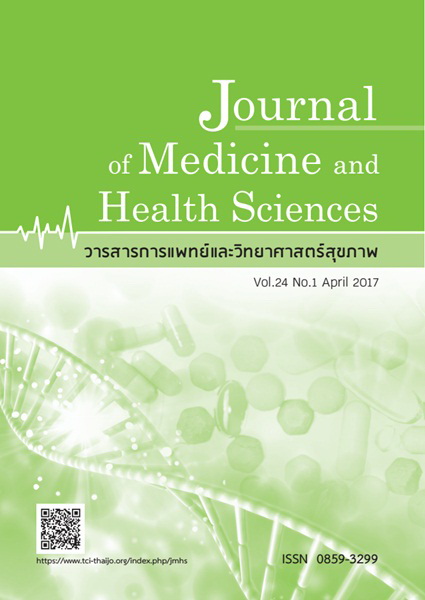การศึกษาการกระจายตัวของ TGF-β1 C-509T ในประชากรไทย/Distribution of TGF-β1 C-509T polymorphism in Thai population
Keywords:
TGF-β1 C-509T, ความหลากหลายของยีน, ประชากรไทย/TGF-β1 C-509T, gene polymorphism, Thai populationAbstract
บทคัดย่อ
ความหลากหลายของยีน Transforming growth factor beta 1 (TGF-β1) C-509T มีความสัมพันธ์กับความรุนแรงของโรคและความไวต่อการเป็นโรคหลายชนิด การศึกษานี้มีวัตถุประสงค์เพื่อศึกษาความหลากหลายของยีน TGF-β1 C-509T (rs1800469) ในประชากรไทย โดยศึกษาในคนไทยปกติจำนวน 56 คน ด้วยวิธี polymerase chain reaction-restriction fragment length polymorphism (PCR-RFLP) จากการศึกษาพบว่ามีความหลากหลายของ TGF-β1 C-509T ดังนี้ CC 12.5%, CT 39.3% และ TT 48.2 % ซึ่งความถี่จีโนไทป์เหล่านี้ในประชากรไทยมีค่าไม่แตกต่างจากกลุ่มประชากรจีน (p=0.390), อิตาลี (p=0.057) เซอเบียร์ (p=0.554) และบราซิล (p=0.442) อย่างมีนัยสำคัญทางสถิติ แต่พบว่ามีความแตกต่างจากประชากรอินเดีย (p=0.005), รัสเซีย (p=0.048), อังกฤษ (p= 0.006) เยอรมนี (p= 0.014) และอียิปต์ (p <0.0001), อย่างมีนัยสำคัญทางสถิติ เมื่อศึกษาความถี่ของอัลลีล C และ T พบว่า อัลลีลที่พบมากในประชากรไทยคือ T ในขณะที่ในประชากรอื่นๆ พบอัลลีล C มากกว่า (p<0.05) การศึกษานี้น่าจะบ่งชี้ให้เห็นว่าความหลากหลายของยีน TGF-β1 C-509T ในประชากรไทยมีความแตกต่างจากประชากรกลุ่มอื่น และอาจนำข้อมูลนี้ไปใช้ในการพัฒนาการพยากรณ์โรคหรือการรักษาโรคได้ต่อไปในอนาคต อย่างไรก็ตามการศึกษาความหลากหลายของยีน เพื่อเป็นการยืนยันผลการศึกษาในครั้งนี้ควรทำการศึกษาในกลุ่มตัวอย่างที่มีขนาดใหญ่ขึ้นต่อไป
Abstract
Transforming growth factor beta 1 (TGF-β1) C-509T gene polymorphism has been found to be associated with severity and susceptibility of many diseases. To examine the distribution of TGF-β1 C-509T (rs1800469) gene polymorphism in Thai population, 56 samples from unrelated healthy Thai volunteers were analyzed by using polymerase chain reaction-restriction fragment length polymorphism (PCR-RFLP) method. The genotype frequencies of TGF-β1 C-509T polymorphisms were as follows: CC 12.5%, CT 39.3% and TT 48.2%, which showed no statistically significant differences to those of Chinese (Han) (p=0.390), Italian (p=0.057), Serbian (p=0.554) and Brazilian (p=0.442) population. However, a statistically significant difference was observed between the genotype frequencies found in this study and those of Indian (p=0.005), Russian (p=0.048), English (p= 0.006), German (p= 0.014), and Egyptian (p<0.0001) population. In addition, statistically significant differences were also observed between allele frequencies in Thai population in this study and those of other reported groups; including, Chinese (Han), Indian, Russian, Italian, English, German, Serbian, Egyptian, and Brazilian (p<0.05). The frequency of T allele in Thai was significantly higher than that of C allele, whereas in other reported groups, the C allele frequencies were significantly higher than T allele frequencies (p<0.05). From the above data, it is likely that the distribution of TGF-β1 C-509T gene polymorphisms in Thai population is different from those of Asian, Caucasian, Egyptian, and Brazilian population. This observation may be useful and could be applied for treatment and prognostic of disease in the future. However, further studies in larger numbers of Thai subjects are required for confirmation.



